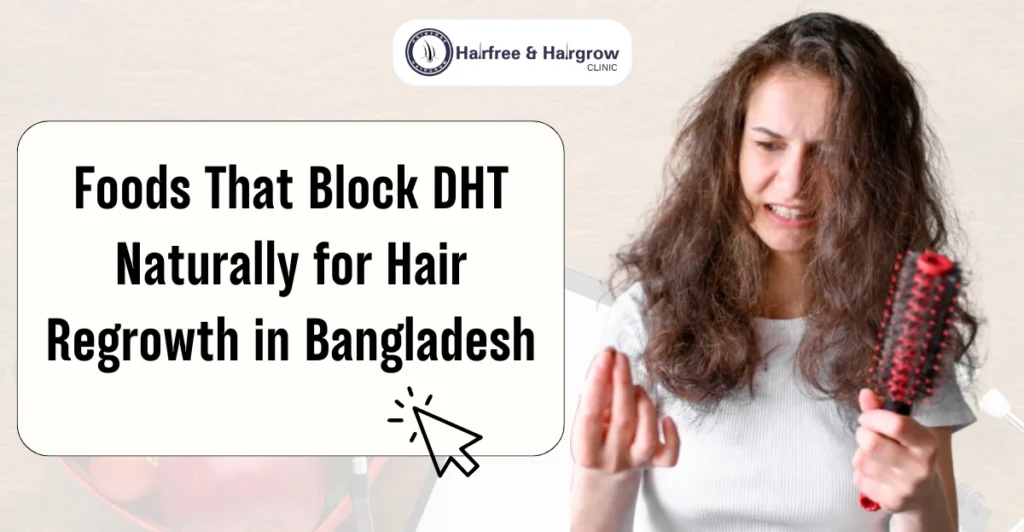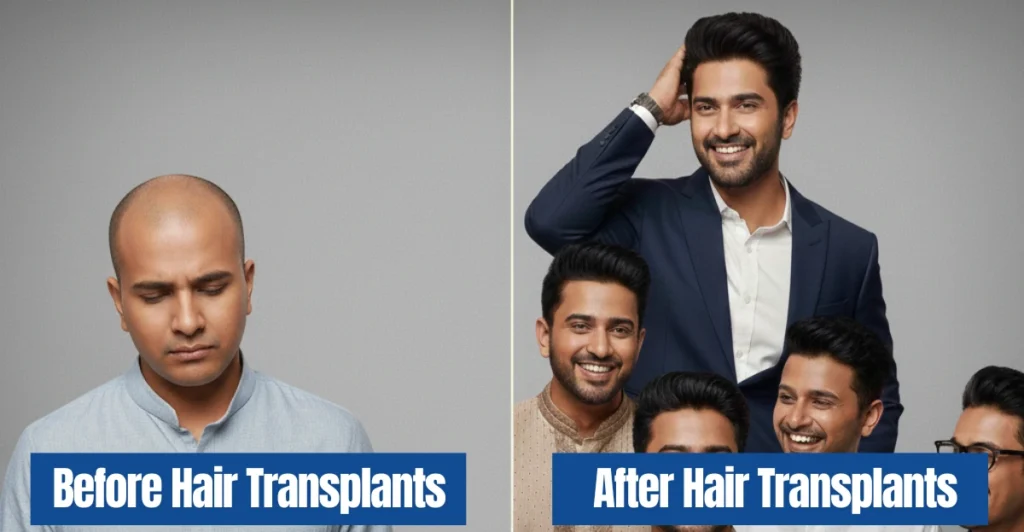Hair loss, thinning, and slow regrowth are common issues faced by many, and while medical treatments like Minoxidil and Finasteride are widely used, not everyone prefers them. As a result, alternatives like PRP (Platelet-Rich Plasma) and GFC (Growth Factor Concentrate) have emerged as popular hair restoration treatments. But how do hair restoration treatments comparison? What are the key differences, and which is more effective?
In this blog post, we’ll explore PRP vs GFC, and their differences, and help you decide which might be right for you.
At Hair Free Hair Grow Bangladesh, we offer both PRP and GFC treatments through our top hair transplant surgeons. With years of expertise and many successful cases, we provide the best PRP treatment in Bangladesh to effectively solve your hair loss problems. Whether you are considering PRP for hair restoration or exploring other advanced options, we are committed to helping you find the most effective solution to your hair loss problems.
Table of Contents

What is PRP?
PRP involves extracting a small amount of your blood, separating it using a centrifuge to concentrate the platelets, and then injecting it back into your scalp. The platelets contain growth factors that help stimulate hair growth by promoting healing and reducing inflammation. There are several types of PRP:
Regular PRP – Plasma with platelets is injected into the scalp.
Activated PRP – A chemical activator, such as calcium chloride, is added to stimulate the release of growth factors before injection.
Bio PRP – Biotin is mixed with the platelet activator for enhanced results.
Here’s how it works:
- A small amount of your blood is drawn, usually between 10-25 ml.
- The blood is then spun in a centrifuge to separate the platelet-rich plasma.
- This plasma, rich in growth factors, is then injected into your scalp.
The growth factors in PRP are believed to activate hair follicle stem cells, promoting hair growth. PRP has been used for various medical purposes, including joint injuries and dentistry, before finding its way into hair restoration.
Benefits of PRP for hair regrowth:
- Uses your own blood, reducing the risk of allergic reactions
- Can be effective for various types of hair loss
- Minimal downtime after treatment
Potential side effects and limitations:
- Mild irritation or pain at the injection site
- Results can vary depending on the quality of PRP preparation
- May require multiple treatments for noticeable results
Read Also: Can Wheat Cause Hair Loss?
What is GFC?
GFC is a second-generation form of PRP. It’s a more advanced and concentrated version, where a higher quantity of growth factors is extracted and injected. GFC offers more consistent results due to its standardized extraction and processing methods. It also remains more stable at room temperature, making the procedure more efficient and reliable. How GFC works:
- A standard amount of blood (usually 20 ml) is drawn.
- The blood is mixed with an activating agent in a special kit.
- After processing, the resulting solution, rich in concentrated growth factors, is injected into the scalp.
GFC aims to deliver a higher concentration of growth factors than traditional PRP.
Benefits of GFC for hair regrowth:
- Standardized preparation method, potentially leading to more consistent results
- May require fewer treatment sessions compared to PRP
- The solution is stable at room temperature for a few hours
- Long Lasting Results
- Improved Hair Health
- Stimulates hair growth
Potential side effects and limitations:
- Mild irritation or pain at the injection site (similar to PRP)
- Higher cost compared to PRP
Our Clinic Location: Hair Transplant in Dhaka
Key Difference Between PRP and GFC
- Extraction and Processing:
- In PRP, blood is drawn, separated via centrifuge, and injected immediately. The process must be completed quickly to avoid platelet degradation.
- GFC uses a specialized kit with vials containing platelet activators, making the process more stable and allowing a 30-minute pause before centrifugation. This standardized process ensures higher concentrations of growth factors and fewer variables.
- Effectiveness:
- PRP’s results can vary significantly depending on the technician’s skill and the specific method used, leading to inconsistent outcomes.
- GFC is more consistent due to its advanced extraction technique, leading to more predictable results with higher growth factor concentration.
- Pain and Side Effects:
- PRP may cause more inflammation or discomfort due to contamination by white or red blood cells during the separation process.
- GFC is an acellular treatment (free from WBCs or RBCs), leading to fewer side effects and less pain.
- Results Timeline:
- PRP typically requires 5-7 sessions, with noticeable results appearing after several months.
- GFC offers quicker results, often showing improvement after just 2-3 sessions within 2-3 months.
- Cost:
- PRP can range from ৳2,600 to ৳13,000 per session, depending on the clinic and quality of the procedure.
- GFC, being more advanced, starts around ৳9,100 and can go up to ৳25,000 per session. A good price range is typically ৳13,000-৳15,600. ( Prices in Bangladeshi Taka)
Which Treatment is Right for You?
Choosing between PRP and GFC depends on several factors:
- Clinic Standards: If you’re going to a reputable clinic with experienced doctors, both PRP and GFC can be effective. However, if you’re unsure about the clinic’s standards, GFC might be a safer choice due to its standardized preparation method.
- Budget: If cost is a significant factor, PRP might be more suitable as it’s generally less expensive.
- Time Commitment: If you prefer fewer treatment sessions, GFC might be a better option.
- Type of Hair Loss: Both treatments can be effective for conditions like androgenetic alopecia and telogen effluvium. There are various hair loss treatment options available, including PRP and GFC therapies, both of which target scalp rejuvenation and hair regrowth. Consult with a hair restoration specialist to determine which treatment is best for your specific condition.
Our Patient: Hair Regrowth Journey with PRP and GFC
For the past few years, I noticed my hair was thinning, and I was feeling less confident. After talking to my doctor, we decided to try PRP and GFC treatments. These treatments use my own blood to create a special solution full of growth factors, which is injected into my scalp to help grow my hair back.
At first, I was nervous, but the procedure was simple and not too painful. Over the next few months, I noticed my hair was growing thicker, and less hair was falling out. Of the two, PRP worked best for me because it showed results faster and required fewer sessions. But everyone’s hair is different, so the best treatment for you may vary. It’s important to consult a doctor to find out what will work best for you.
Conclusion
Both PRP and GFC are promising treatments for hair restoration, using your body’s own growth factors to stimulate hair growth. While PRP has been around longer and has more research backing it, GFC offers a more standardized approach with potentially more concentrated growth factors.
The choice between the two often comes down to individual factors like budget, clinic reputation, and personal preferences. When it comes to hair regrowth solutions, treatments like Minoxidil and Finasteride are often combined with advanced therapies like GFC to improve results.
Frequently Asked Question
Both can be effective, but GFC may offer more consistent results due to its standardized preparation method. However, individual results can vary.
PRP requires 4-6 sessions, while GFC may show results in 3-4 sessions. However, this can vary based on individual response to treatment.
GFC is generally about 1.5 times more expensive than PRP. For example, if PRP costs around Rs.5000, GFC might cost Rs.7000-8000.
Both treatments can be effective for people with androgenetic alopecia (male or female pattern baldness) and telogen effluvium (temporary hair shedding). However, it's best to consult with a hair restoration specialist to determine if you're a good candidate.

Written By
Dr. Nazmin Nipa
Medical Officer & Hair Transplant Surgeon
Dr. Nazmin Sultana Nipa is a distinguished hair transplant doctor in Bangladesh, known for her advanced skills in hair restoration. As a Medical Officer and Hair Transplant Surgeon, Dr. Nipa combines her extensive experience in the field with a focus on transparency and patient-centered care.
Disclaimer
We’ve made all possible efforts to ensure that the information provided here is accurate, up-to-date and complete, however, it should not be treated as a substitute for professional medical advice, diagnosis or treatment. See Detailed Disclaimers Here.



